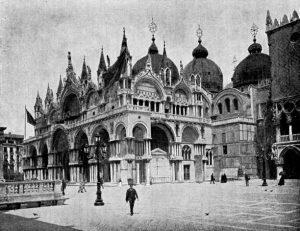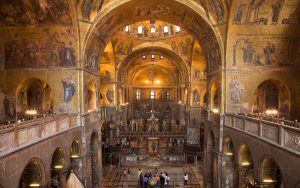
Giovanni Gabrieli (c.1557-1612)
The great composer Giovanni Gabrieli was the innovator who at the end of the 16th century brought forth the first murmurs of the new instrumental style of music that will replace the style of polyphonic music that had dominated music for seven-hundred years. We don’t know where Gabrieli was born, but he was the nephew and the pupil of Andrea Gabrieli (c.1533-1585), the eminent organist, composer, and teacher at San Marco: the beautiful cathedral in Venice known to the English-speaking world as St. Mark’s. By 1575, Giovanni had gone to Munich to study with the great Renaissance composer Orlando Lasso. Then, in the early 1580s or thereabout, he returned to Venice. On January 1st, 1585, a competition was held to select an organist at San Marco and Giovanni won. After becoming San Marco’s organist, he began composing some very extraordinary and revolutionary instrumental and choral compositions.

The Antiphonal Choirs of San Marco

There was a tradition in the great Venice cathedral to use the two choir lofts on either side of the main altar for two separate choirs, each with its own organ, singing antiphonally. This tradition, also called polychoral (music composed for more that one choir), had been in place in San Marco since perhaps the 15th century, and had become famous throughout Europe when the great Flemish composer Adrian Willaert (c.1490-1562), who was the maestro di cappella (chapel master) between 1527 and 1562, published Salmi spezzati – antiphonal settings of psalms – in 1550: works that influenced composers during the later 16th century. Willaert’s successors at San Marco continued the tradition of using the two choir lofts to utilize the spacial dynamics of the cathedral to create interesting polychoral music.
Giovanni’s uncle and teacher, Andrea Gabrieli passed away in 1585. Giovanni, in addition to his duties and additionally composing his own music, prepared his uncle’s music for publication. Two years later, in 1587, he published Concerti di Andrea, et di Giovanni Gabrieli containing 77 works, mostly those of Andrea, along with some of Giovanni’s polychoral motets. This became a very influencial volume of music.
Gabrieli then extended the tradition at San Marco by creating innovative sacred choral compositions that included instruments, and even extended the polychoral concept to three and even four different choirs, all spaced above the congregation in the lofts of San Marco.
A New Music
Giovanni Gabrieli was called the “Father of the chromatic style” because of his bold modulations. He was also one of the first, if not the very first, composer to employ a separate bass line, an idea that will become the underpinnings of the new music of the 17th century.
He wrote magnificently for instruments, choir, and a combination of both, and he was the first composer to specify violins in a score. This alone qualifies him as one of the fathers of our classical music tradition, and to him must be given the credit for opening the door for the new music that came to life at the beginning of the 17th Century. He was also the first to really develop instrumental music. In addition to his sacred choral compositions, he created canzoni for brass and strings, and ricercari for keyboard instruments and for strings.
The first known example of orchestration occurs in Giovanni Gabrieli’s Sacrae Symphoniae published in 1597, where instruments are specified, and where the violin was first specified in music. The violin was already fully developed by this time, except that the neck was shorter, and the bridge was flatter.
Giovanni and his uncle Andrea were also the first to use the term concerto in the 1587 publication Concerti di Andrea, et di Giovanni Gabrieli. The violin had become emancipated, and it, along with the rest of the violin family, will become the mainstay of 17th century music. In the later part of the century, the concerto will become the medium of expression for this family of instruments that will be manufactured in Italy by the greatest luthiers who ever lived: names such as Amati and Stratovarius.
Gabrieli is not only a very important composer historically, but also a composer of sublime music. His magnificent choral works, such as “Plaudite omnis terra” and “O Magnum Mysterium” belong in category of the greatest compositions of all time.
The Great “The Glory of Gabrieli” Album from 1968
How I Discovered the Great "The Glory of Gabrieli" Album
By Don Robertson
This is a short story about how I discovered the great music of Giovanni Gabrieli.
After the publication of my book Kosmon in 1970, I continued my quest to uncover the world’s great positive music by listening to music that I believed was either emotionally or spiritually positive in its effect. I had learned about the cantatas that had been composed by the great composer Johann Sebastian Bach from a wonderful man named Charles Hofmann when I previously lived in New York City. He had been the staff accompanist for the Silent Film Theatre in the Museum of Modern Art.
It was now 1971, and I was living in San Francisco. I had obtained recordings of Bach’s cantatas from the public library in downtown San Francisco, near where I was living at the time. This fine old library, whose great building had first opened in 1879, and on whose shelves were contained volumes that had rested there for many years, proved to be a fantastic resource for me.
One night after a quiet evening listening to Bach’s Easter Cantata, I went to bed, and I had an eventful dream wherein I found myself standing in the San Francisco Public Library’s listening room: where the long play (LP) record albums and turntables with earphones were located. In the dream, on a shelf in front of me, I clearly saw an album with the name Palestrina on it, and I knew that the name belonged to the great Renaissance composer Giovanni da Palestrina (c.1525-1594). I had heard of him in a music appreciation course that I had taken years before at Colorado University, but I was unfamiliar with his music. Then in the dream, I heard a voice that said:
“There are great composers who lived before the time of Bach.”
I awoke, startled, and surprised.
All day, I pondered that dream. Most people I had met in the so-called classical music world considered music composed before Bach’s time to be of no current value. Never did I remember hearing music from Palestrina’s period (the 16th century – two centuries before Bach) publicly performed or featured on classical music radio programs. The absence of interest in the sacred choral music of the 16th century and its great acknowledged master, Giovanni de Palestrina, spoke volumes about Renaissance music’s acceptance as a valid musical art form. Basically, it was underperformed music that lay fallow on the musical vines of history.
Then immediately, I remembered a stunning Magnifcat composed by Renaissance composer Cristóbal de Morales that I had heard in the music room at Colorado University, and how that music had left a strong impression on me. I had afterward looked for a recording of that music in record stores, but never found one, as the recording that I had listened to at the university was a part of a special educational collection.
I took my dream very seriously. As soon as possible, I made a trip to the library, and there I found a few recordings of Palestrina’s music. I took them home and listened to them for about a week. The music, which I listened to at every opportunity, seemed empty and dry to me and it all sounded the same. I had become used to hearing drums and the different timbers of instruments, not the sound of an unaccompanied choir. I could also not discern any recognizable themes. Because I was so used to orchestral music with multiple timbres and wide dynamic ranges, climaxes, and “hooks” that Palestrina’s themes were not registering with me. But I just kept on listening, wondering what the dream was trying to tell me.
Then one day it happened! While listening, I suddenly started hearing the music, and what music it was! It was powerful and spiritual!
After two weeks, I returned to the library to renew the Palestrina records when much to my surprise, I found my friend Rebecca Campbell standing at one of the listening stations with earphones on. She was very absorbed in some music. I had no idea that she also liked to visit the music room of this great old public library. She saw me, and excitedly beckoned me over.
“Plug in another set of earphones,” she said.
When I did, I heard magnificent music that was so powerful, so spiritual, so great, that I almost went into shock! I looked at Rebecca, who was beaming, and we both began laughing ecstatically, loudly. The librarian came over and told us be silent, or we would have to leave the library.
Apparently, Rebecca had just discovered the record that we were listening to at the exact time when I had walked in. What kind of “coincidence” was that?
The music was by the great 16th-century Renaissance composer Giovanni Gabrieli. It was not soft, flowing and even keeled like that of Palestrina. It was loud, full of joy, passion, and praise, accompanied by a big, powerful organ. We were listening to “Plaudite omnis terra” on a high-quality album called The Glory of Gabrieli that featured the organist E. Power Biggs, the Texas Boys Choir, and the Greg Smith Singers, all recorded in the magnificent cathedral where Gabrieli had composed the music: San Marco in Venice, Italy.
A dream, and now a “coincidence.” It was 1971, and I was uncovering a new (for me) world of great spiritual music.
